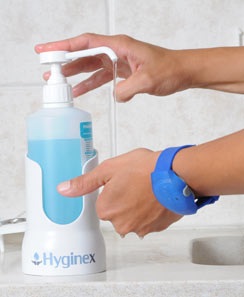According to the CDC, there were an estimated 1.7 million health care related infections in 2002 alone. Health care related infections cause 90,000 deaths and over $30 billion annually in related costs including additional medication to treat the infections and in some cases, legal ones. These infections are frequently acquired while undergoing treatment such as having surgery or dialysis. Just a few of the diseases and organisms involved are hepatitis, MRSA, C.diff, influenza, and norovirus. Stopping their spread in a healthcare institution can be done in one simple, but frequently overlooked procedure: having personnel who come into direct contact with patients wash their hands upon entering and exiting exam, treatment, and patient rooms.
 Providing friendly reminders to the personnel while ensuring compliance with good hand hygiene is what theHyginex system is all about. It provides management at clinics and hospitals with a way to unobtrusively monitor compliance with the protocols established by the facility. A worker wears a bracelet that resembles a wrist watch. The bracelet has two functions. It reminds him or her to wash or re-wash his or her hands when needed courtesy of an LED display, and it monitors hand washing habits with a device that allows it to wirelessly interface with sensors and transmitters mounted on taps and sanitizer dispensers provided by the company. No special tools are needed to install them.They monitor the workers' hand hygiene habits to ensure that they are washing their hands or applying hand sanitizer in compliance with guidelines developed by the Hand Hygiene Center. The data is transferred to a server which then analyzes the information and provides a detailed report on handwashing behavior of departments and individuals to management as well as information in real time to be displayed via an interface on computers in administrative offices and on the units. Additionally, the data may be used for research purposes. If needed, a worker who needs support in efforts to comply with the protocols can be sent tips based on individual habits and progress.
Providing friendly reminders to the personnel while ensuring compliance with good hand hygiene is what theHyginex system is all about. It provides management at clinics and hospitals with a way to unobtrusively monitor compliance with the protocols established by the facility. A worker wears a bracelet that resembles a wrist watch. The bracelet has two functions. It reminds him or her to wash or re-wash his or her hands when needed courtesy of an LED display, and it monitors hand washing habits with a device that allows it to wirelessly interface with sensors and transmitters mounted on taps and sanitizer dispensers provided by the company. No special tools are needed to install them.They monitor the workers' hand hygiene habits to ensure that they are washing their hands or applying hand sanitizer in compliance with guidelines developed by the Hand Hygiene Center. The data is transferred to a server which then analyzes the information and provides a detailed report on handwashing behavior of departments and individuals to management as well as information in real time to be displayed via an interface on computers in administrative offices and on the units. Additionally, the data may be used for research purposes. If needed, a worker who needs support in efforts to comply with the protocols can be sent tips based on individual habits and progress.
A recent report by the Hand Hygiene Center shows that only a 40% adherence to hand washing protocols while following them properly has been shown to cut the risk of infectious disease transmission by 50%. Some of the factors involved in low compliance with hand washing protocols include a lack of awareness that hands may become contaminated in even low-risk patient contact such as a blood pressure check or touching intact skin; pressured work environments that cause a worker to wash for less than the recommended twenty seconds; or circumstances that impede access to a sink or to a sanitizer dispenser. The administration may then use the information in planning facility modifications which would include the placement of new plumbing fixtures or the installation of sanitizer dispensing pumps.
The Hyginex system would benefit hospitals, clinics, doctors' offices, and long term health care facilities such as nursing homes and rehab centers. Its dual purpose of reminding personnel of hand washing protocols and procedures and gathering data for administrative purposes supports a simple, effective way to decrease both cost and suffering associated with health care related infections.
Fran Jablway
and
Hulet Smith, OT